WINNERS OF 2015
Diploma of the Ist degree of the competition named after Lev Knyazkov and prize money:
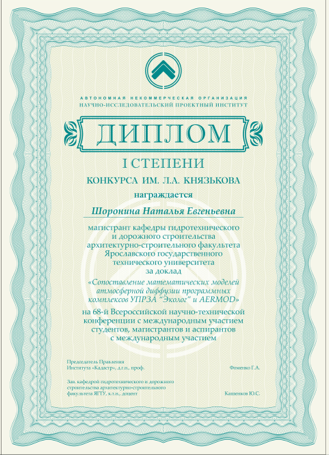 Natalia Shoronina – undergraduate of the department of hydro-technical and road construction of the architectural-construction faculty of Yaroslavl State Technical University for the work “Comparison of mathematic models of atmospheric diffusion of software complexes “Ecologist” and AERMOD”.
Natalia Shoronina – undergraduate of the department of hydro-technical and road construction of the architectural-construction faculty of Yaroslavl State Technical University for the work “Comparison of mathematic models of atmospheric diffusion of software complexes “Ecologist” and AERMOD”.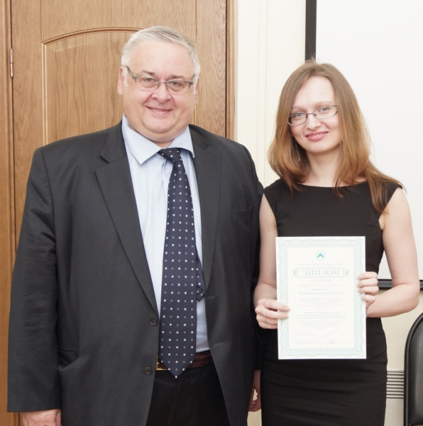
Modern environment is under constant “anthropogenic stress” that appears as degradation of biosphere. First of all, it is connected with active urbanization of urban territories. Big industrial towns suffer from significant chemical load. Main input to air pollution relates to emission form vehicles. Increase of urbanized areas necessitates improving of quality of assessments of the state of environment, as well as the development of new methods of assessment of exposition loads and calculations of dispersion of pollutants. Adequate methodological approach and instruments are necessary for: (1) forecast of air pollution, (2) management of air quality based on maximum precise calculation of concentrations of pollutants with the use of meteorological information, (3) application of data of air quality observation points, (4) account of mean concentrations for making prediction long-term assessments of air quality. Prediction modelling of dispersion of pollutantys in the air is aimed at addressing those issues. It allows to perform a priori analysis of negative impact of numerous pollution sources with the account of relief and wind characteristics, to perform prediction calculations. Thus, it becomes possible to supplement the results of monitoring observations and inventory of emissions of industrial enterprises and vehicles in the course of the assessment of environment and human health impact. Therefore, the main task was: to study peculiarities of application, to assess software complex “Ecologist” widely used in Russia and top compare it with new software complex AERMOD, that apply different mathematic models of atmospheric diffusion.
Scientific adviser - G. Fomenko, Doctor of Geographical Sciences, professor, academician of the Russian Academy of Natural Sciences
Diploma of the Ist degree of the competition named after Lev Knyazkov and prize money:
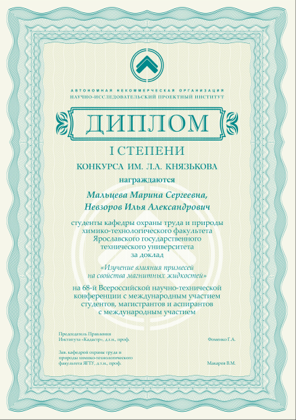 Irina Maltseva, Ilya Nevzorov – students of the department of protection of labor and nature of chemical-technological faculty of Yaroslavl State Technical University for the work “Studies of the influence of admixtures on qualities of magnetic liquids”.
Irina Maltseva, Ilya Nevzorov – students of the department of protection of labor and nature of chemical-technological faculty of Yaroslavl State Technical University for the work “Studies of the influence of admixtures on qualities of magnetic liquids”.
Similar to solid municipal wastes, industrial wastes are various in their chemical composition. The most dangerous wastes of industries are connected with highly toxic elements and compounds. Creation of disposal technologies that allows to perform complex processing of natural raw materials might be a radical solution of the problem of environmental pollution. The bigger part of industrial wastes contains valuable components that might be used as a raw materials in the course of obtaining necessary products. For example, increased concentration of iron compounds in galvanic sludges of some enterprises makes it possible to use wastes as a sources of ferric iron for getting magnetic liquids (ML) that are suspension of nano-dispersed magnetic particles, stabilized in carrying liquid. Magnetic liquids might be applied in various technological processes. In order to get high-quality magnetic liquids (stable, with high magnetic qualities) it is necessary to perform a study on the impact of admixtures of ions of heavy metals, contained in galvanic sludges, on qualities of magnetic substances that are produced from them. Model galvanic sludges consisting of admixtures of ions of heavy metals were the object of the given study.
Scientific adviser - S. Kalaeva, Candidate of Technical Sciences, assistant professor
Diploma of the II degree of the competition named after Lev Knyazkov and prize money:
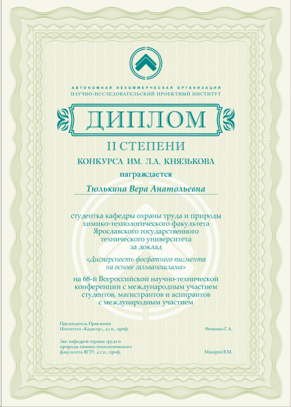 Vera Tulkina – student of the department of protection of labor and nature of chemical-technological faculty of Yaroslavl State Technical University for the work “Dispersion of phosphate pigment on the basis of galvanic sludge”.
Vera Tulkina – student of the department of protection of labor and nature of chemical-technological faculty of Yaroslavl State Technical University for the work “Dispersion of phosphate pigment on the basis of galvanic sludge”.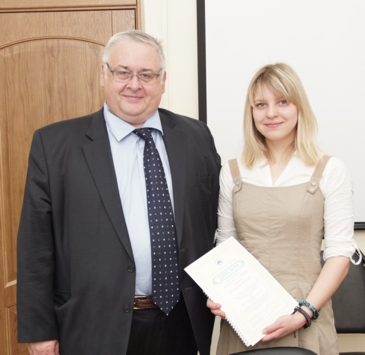
Scientific adviser - G. Efimova, Candidate of Chemistry Sciences, assistant professor